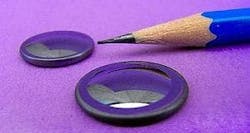IR lens costs lowered by 70% by molding, says Fraunhofer
Freiburg, Germany--A production process developed at the Fraunhofer Institute for Mechanics of Materials (IWM) could make IR lenses (of the sort used in thermal and night-vision cameras) up to 70% cheaper than traditionally made lenses.
Microbolometers used in automobile night-vision systems constitute one way of extending the human eye’s vision and defusing dangerous situations—for example a deer about to run out in front of a car on a rainy night. Microbolometers detect IR radiation and in case of danger, warn the driver through an acoustic signal or a warning light. But, at about 2000 Euros, these devices are still quite expensive and are only being used in luxury-class vehicles.
Part for part, these devices should be getting more affordable. Researchers at Fraunhofer IWM are working on reducing the cost of the IR lenses, which are usually made out of crystalline materials like germanium, zinc selenide, or zinc sulfide. The problem is that these materials are very expensive and can only be processed mechanically—it takes grinding and polishing or diamond turning to shape them into the correct form. Obviously this involves high processing costs.
“Instead of crystalline materials, we use amorphous chalcogenide glass,” says Helen Müller, a scientist at IWM. “Its softening temperature (that is, the temperature at which it can be formed) is low. Therefore, we can form it using nonisothermic hot stamping.”
The process is similar to making waffles on a waffle iron. The researchers place the chalcogenide glass between two pressing tools that determine the form of the required lenses. Then, it is heated and formed between both pressing tools. After a few minutes, the glass is cooled again to below the softening temperature and removed, producing a lens in its final form.
The lenses manufactured this way exhibit the same high optical quality as those that are polished. To ensure that no glass remains attached to the tools, the tool surfaces are coated with antiadhesive nonstick coatings, similar to the Teflon coating on a waffle iron. The scientists want to further refine the process towards cost-effective mass production.
It should be noted that this is not the only time molded chalcogenide glass lenses have been put into production; for example, LightPath Technologies (Orlando, FL) makes such lenses.
About the Author
John Wallace
Senior Technical Editor (1998-2022)
John Wallace was with Laser Focus World for nearly 25 years, retiring in late June 2022. He obtained a bachelor's degree in mechanical engineering and physics at Rutgers University and a master's in optical engineering at the University of Rochester. Before becoming an editor, John worked as an engineer at RCA, Exxon, Eastman Kodak, and GCA Corporation.

